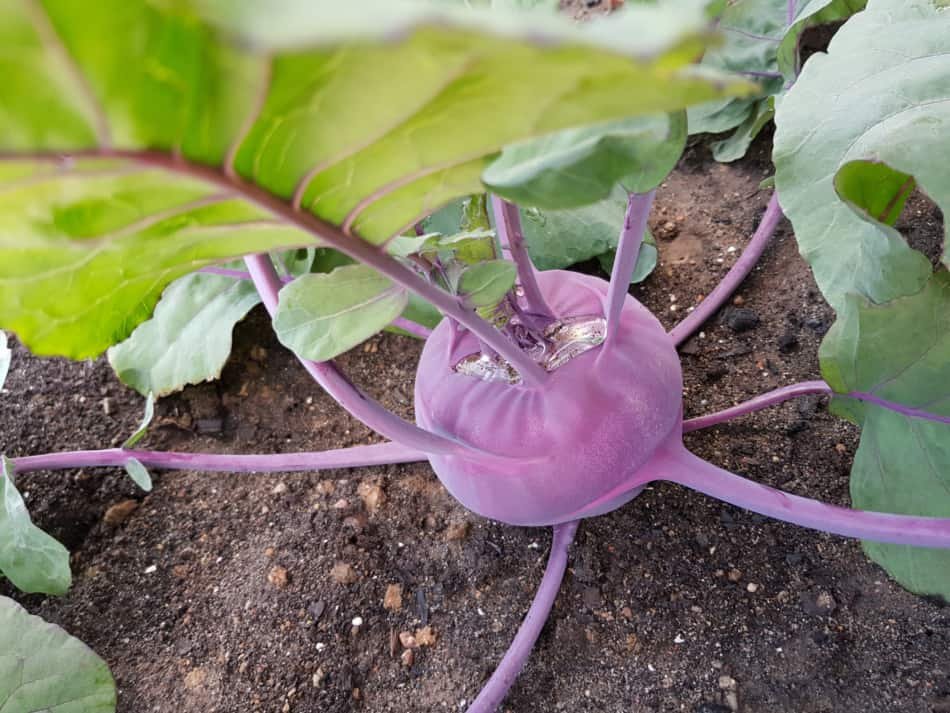If you are unfamiliar with kohlrabi, it may look daunting to try and grow in your kitchen – yet don’t let its unique appearance deter you – don’t be put off – its juicy, fresh, and versatile character make kohlrabi an amazing ingredient to include! Give it a go once at least!
Have you tried your hand at growing kohlrabi with limited success? One way to increase the odds is to begin sowing indoors.
Kohlrabi transplants well and is often an effective way to extend your season in spring. Beginning your seeds indoors as early as February is ideal since kohlrabi needs cool temperatures to flourish; direct sowing it won’t give it enough time before temperatures warm up and develop fully.
Kohlrabi prefers cooler nights in the 40degF (5degC) to 50degF (10degC) range and does not thrive once day temperatures reach 80degF (27degC). Therefore, if your region experiences only brief spring seasons it’s wise to plant brassicas such as cabbage, kale and turnips as soon as possible in your garden plots.
Weather extremes such as high heat or drought may prevent your kohlrabi plants from producing bulbs or cause them to crack and turn woody, while still offering edible leaves and fruit. To minimize this from happening, sowing seeds at appropriate times of the year and using transplants instead of direct sowing may be helpful in keeping kohlrabi alive and producing its desirable fruits.
Here’s all you need to know about transplanting kohlrabi:
1. Kohlrabi transplants should be at least 4 weeks old.
For most temperate climates with long winters and short springs, the soil is workable in March, and even sooner than that. I garden in zone 6B, and it makes sense for me to start my kohlrabi seeds in mid to end of February and transplant them outside at the end of March.
While you can grow kohlrabi seedlings indoors for longer, if you are using smaller modules, 4 weeks is the optimum time to transplant them outside. Otherwise, you risk getting the seedlings rootbound and stunt their growth. You can check this by gently lifting a plant and seeing if roots have taken over the exterior of the starting mix.
If you still have snow in the ground and your kohlrabi seedlings are already 4 weeks old, pot them on in larger containers or plant them under a cold frame. But generally, they can last 1-2 weeks longer in the same modules. Once in the ground, you can ease the transplant shock by covering them with one or two layers of fleece directly on top, no hoops needed.
2. You need to thin kohlrabi transplants early on.
It’s a good idea to sow a few more seeds of kohlrabi than needed in your module trays. This way, you can ensure a higher rate of germination.
Unlike beetroot and radishes that don’t mind being grown in clumps, kohlrabi grows best as a single seedling, so you will need to thin them. If the seedlings compete for space and nutrients, they won’t develop as sturdy and thick.
But don’t just discard the other seedlings – you can transplant them to another module and multiply your kohlrabi seedlings using this method.
If you’re looking to get your kohlrabi starts from your local garden center, look for the ones that have multiple seedlings inside one cell and separate them to obtain more plants than what you paid for.
Often times, the seedlings at the garden center are older, with bulbs already starting to form. In spite of getting older plants, you can still separate them. Even if you’re breaking a few roots, they will recover.
Try keeping a few spare seedlings after transplanting kohlrabi in the ground – some might not do so well, and they might need replacing. It’s always good to have spare seedlings.
3. You can fix legginess when planting kohlrabi seedlings in the ground.
Starting seeds isn’t always straightforward. Often times we can lose seedlings to damping off disease, or they grow tall and leggy because they’re not getting enough light.
Just like any other seedlings, kohlrabi needs a lot of light to grow, but the base stem will still be a little leggy when the seedlings are young. If you have kohlrabi seedlings that seem healthy but can’t stand upright and look spindly and floppy, don’t worry, it’s normal.
You can easily fix this issue by burying them up to their first leaves when transplanting them in your raised beds. This will strengthen their base stem. Be careful not to only cover the future bulb with soil. Kohlrabi doesn’t grow roots in the ground, but rather, bulbs that swell above soil level. So make sure not to plant them too deeply.
Young seedlings, especially the ones suffering from transplant shock, can look floppy for a couple of days. Watering also causes them to fall over. But once they establish and start growing, you’ll no longer have that problem.
Make sure to transplant them 6 to 8 inches apart, on a cool, overcast day, preferably in the evening, as the strong sun is their biggest enemy at this stage. This way, they will have time to establish the roots in the ground overnight.
The same goes for transplanting kohlrabi seedlings from small modules to bigger pots – let them rest without growing lights for at least half of the day.
4. You can transplant kohlrabi as a fall crop as well.
Though typically associated with spring vegetables, kohlrabi can make for an excellent fall crop due to its cold hardiness. Not only is it frost-resistant but even thrives during light autumn frosts–if anything, its sweeter sweetness makes for better flavors overall!
To grow kohlrabi from transplants as a fall crop, count backward from your last frost date 45-60 days and sow seeds. For optimal harvest conditions in late July or early August. This way, you can harvest great kohlrabi that is enhanced by the cold instead of becoming woody or going to seed from the hot weather. Fall harvests also have the advantage of storing for longer.
5. The reason why direct sowing kohlrabi is difficult.
If you have short springs and hot summers, directly sown kohlrabi won’t do well in places where the ground is still covered with snow in March. Sowing seeds directly in the ground in mid-March is already too late, as April and May will bring along warm days.
The only way direct seeding can work in spring is if you live in a cool, humid area with plenty of rain and mild summers. If your soil isn’t frozen in February then you have a good chance of growing kohlrabi that doesn’t become woody.
Sowing kohlrabi seeds during the summer for fall harvest is often challenging due to germination being impossible at high temperatures – anything above 90degF (32degC) won’t allow any sprouting at all, in which case either wait until weather conditions cool off, or start seedlings indoors where temperature controls can help manage temperatures more effectively.
Conclusion
Generally, starting kohlrabi and other brassicas indoors, in module trays, instead of sowing them outside, is a great method to increase the yield of a small garden, because you have absolute control.
You won’t have to worry about uneven germination or thinning and you will be able to place your kohlrabi plants wherever you want in the garden, as they don’t occupy a lot of space.

